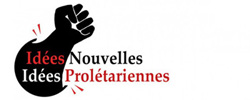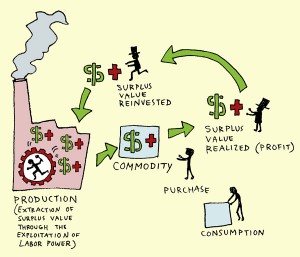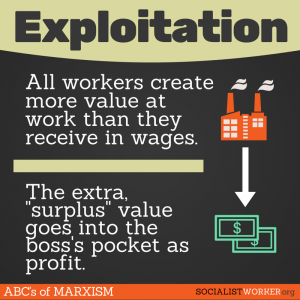Jan Makandal
October 20, 2015
Marxism is not a self-contained, complete system resting on a philosophical base. Rather, it is a theory that has no absolute beginning and is constantly incomplete in its elaboration, as a whole or in any of its aspects (for example the economic aspect as elaborated in Marx’s Capital).
This doesn’t mean Marxism is non-scientific or non-systematic. It clearly defines objects of study in order to explain their objective necessities, establishing its systematic characteristic of analyzing the different forms of class struggle, and the connections between these struggles.
Marxism argues that the history of any society is the history of class struggles. This doesn’t mean that class struggle is merely the principal phenomenon that we can observe in history; instead Marxism asserts that all historical phenomena are diverse and complex historical forms of class struggle.
When a self-defined revolutionary organization pretends to define the “ABCs of Marxism,” it is not only assigning a false beginning to something that is perpetually incomplete, but it is also assigning a false permanency to an interpretation of a reality that is in a constant mode of evolution. Such an approach can only realize dogmatism. It is a reversal, a reduction from an unfinished science to a finished one.
The “ABCs of Marxism,” a series of graphics with texts, or memes, by the International Socialist Organization (ISO) display that erroneous approach. Marxism, with its periodization, cannot be learned by rote. It is to be applied, reinforced, and most importantly it is to be in a constant mode of rectification.
In one of the “ABCs” series, headed “Exploitation,” the ISO attempts to define surplus value this way: “All workers create more value at work than they receive in wages. The extra ‘surplus’ value goes in the boss’s pocket as profit.” [See graphic at end of this piece for reference].
In a paragraph of text added to the graphic in a Facebook post, the Chicago chapter of the ISO developed a technical mechanism to get that money back: “When we say ‘tax the rich’ we’re really just saying ‘give workers back what the bosses stole.’ And once you start thinking about it like this, it becomes obvious to ask whether it’s possible to simply do away with the original theft—the exploitation—itself.”
But confining our goal to simply doing away with exploitation opens the door to reformism, to alternatives other than revolution. Under this conception, the creation of a Labor Party would be another possible route, since presumably if elected they could tax the rich and return profit to the worker. Lowering the cost of labor reproduction through increasing relative surplus value (taxing the rich to fund social programs) would be yet another possible route for the ISO. Whether the ISO advocates a revolution or an electoral or a legislative path, this conception will not be able to lead to a radical transformation of the mode of production from capitalism to something totally different. It cannot possibly realize anything more than a “system upgrade” or a reformed capitalism.
The quintessence of the theory of the capitalist mode of production in Capital is the analysis of surplus value. This establishes Marx’s rupture from political economy, sociology and bourgeois historiography.
What defines capital in a bourgeois economy is the valorization of a given quantity of value. Not all sums of value are immediately capital; it depends on their utilization. For example, a sum of money in a piggybank is not capital. To be capital, the value must be invested for accumulation. This quantity, by definition, is surplus value.
Surplus value is realizable as soon as it’s assigned to capital for accumulation, a never-ending process. This process may appear different based on different modes of investment. However, money is the most advanced and most privileged form of investment. The money form is the equivalent of all merchandise, including the means of production. Because productivity is necessary to the functioning of industrial capital, money represents the value of the material objects it is temporarily attached to. But the movement of capital is not really interested in those objects; money has value independently on its own, in itself. Essentially the movement of capital is for monetary accumulation, a developed form of circulation of money.
Surplus value is a profit, but not all profit is surplus value, even though the labor power that produces the surplus value (the origin of all capital) is transferred and destroyed in all forms of circulation and concentration of capital.
The ISO’s “ABCs of Marxism” is nothing but a caricature of Marxism, a merely Marxist-flavored definition with all the nuance of a Powerpoint slide show that reduces surplus value to a description. This caricatured approach can only lead to an eclectic usage of the concept of surplus value, because anyone with that limited understanding will be incapable of developing the concept. Worse, they will substitute the theory of surplus value and its forms with a simple theory of profits, of realization of profit and circulation of capital, such stated by the ISO: “the extra ‘surplus’ value goes in the boss’s pocket as profit.”
This is exactly what Marx vehemently critiqued of the intellectual bourgeois circle of his time. Marx denounced the approach of Ricardo, who tried to define surplus value and the processes of capitalization of surplus value in terms of profit.
This is an important point. It is not a matter of semantics. A wrong definition of the theory of surplus value will only contribute to the realization of reformism, opportunism and populism. The correct appropriation of surplus value, on the other hand, is simultaneously the construction of a political line; it is scientific socialism.
The petite bourgeoisie (including those of the ISO) is usually quick to give a reformist definition of socialism: the control of the means of production. For the proletariat, this definition is only partially correct. On its own, it is reformism and revisionism, because the control of the means of production could be achieved by judicial means. This is why the petite bourgeoisie is eager to identify as socialist any populist judicial measures taken by a government (such as Venezuela) or promises made by a candidate (such as Bernie Sanders). These judicial measures could be achieved either by suffrage (if these petit bourgeois elements weren’t such vile opportunists and would be willing to face the power), or by revolution.
In any case, for proletarian revolutionaries it is not simply a matter of control of the means of production. That is necessary and included, but it is not enough. The determining factor is the destruction, at the level of the economy, of all forms of concentration of capital and of all forms of circulation of capital.
In the transition period of scientific socialism, the fundamental aspect is a new set of contradictions: between proletarian dictatorship and the dissolution of proletarian dictatorship. That dissolution is the dissolution of classes. Only the proletariat can lead the whole popular camp on the path of its own destruction, by destroying all forms of concentration of capital.
Marx and Engels were correct to affirm the discovery of surplus value as the understanding of scientific socialism. Practice has not yet achieved that level of appropriation. Indeed, we must admit that in the Russian revolution these points were only addressed in theory. In China we can say that we have witnessed some sincere practice of addressing this new set of contradictions, but this was severely repressed by the capitalist roaders.
Marxism is a scientific theory and the most advanced theory, still unfinished, incomplete, even if dogmatists of the left seem to deny that. Even in his epoch, Marx was systematic enough to warn us that his contribution to that science (which we call Marxism and our political current identifies as Proletarian Theory) was a critique of political economy. Now we can see the importance of that subtitle in Capital. For us it firmly emphasizes that this science is not for fixing capitalism. No one can use this science to fix capitalism. The ISO presumes the ability to do so by taxing the rich and returning the profit to workers (whatever their definition of workers might be).
Proletarian theory contains two intimately linked opposite dualities: the appropriation of all forms of concentration of capital on the one hand, and on the other hand proletarian revolution that decimates and destroys all those forms of concentration of capital and its circulation (from which surplus value is the original source). This is what all the variations of Marxist-flavored reformist theories seem to dismiss.
If surplus value is profit but not simply profit, not limited to being profit, then what is it?
To understand surplus value we must consider capital at a social level scale, not as a simple “surplus” that goes into the pocket of the boss, as conceptualized by the ISO, others of the left, and bourgeois intellectuals at the service of capital. Such a declaration really limits our appropriation of capital and concentration of capital, especially at a time characterized by the following:
1) The concentration of capital determines the complex historical movement of capital, including its division into individual capitals, the fusion between industrialists and financiers, and the various functions necessary for its own reproduction: material production, circulation of goods, and circulation of money. In all of these cases, the main aim is to accelerate the rotation of capital to constantly augment the rate of profit and open the possibility of credit (circulation of money).
2) The concentration of capital produces, in turn, fundamental transformations in the forms of capitalist property. Production for individual private capitalists is becoming obsolete, a thing of the past, and is gradually becoming geared toward groups of capitalists. This facilitates capitalists, a class of private owners, in appropriating a portion of the social capital. It also facilitates the constant historical formation of classes, class fusion, class transfer, and class dissolution as aspects of the constant formation of the power bloc that dominates society.
For us, surplus value is the source of all other forms of capital and all forms of concentration of capital. It is what distinguishes capitalism from all other modes of production. Any mode of production is fundamentally characterized by its relations of production, which it presupposed and reproduces, between direct producers (productive labor), non-producers, and means of production. Setting aside the primary communes, historically and dominantly (almost exclusively) all modes of production have been modes of exploitation of social labor. This is the reason that proletarian theory is confirming that the problematic of all historic modes of production is the problematic of historical forms of exploitation. The problematic of all historical forms of exploitation are, as well, historical forms of struggle against exploitation.
Under capitalism, the problematic of historical forms of struggle against exploitation is also the problematic of historical forms of struggle to abolish classes. The problematic of taxing the rich will not lead to the abolition of classes, but simply to legislative measures (still determined by class struggle). What makes it a reformist struggle is its permanency under a bourgeois mode of production.
What is characteristic of the capitalist mode of production is the relations of production that antagonistically oppose the working class/productive labor against capital in the process of the production of surplus value. The existence of surplus value distinguishes the capitalist mode of production from any other mode of production.
Surplus value is not simply an added value that goes into the pockets of the bosses. This is a purely quantitative definition of surplus value. Though all production of surplus value does require an accounting of value and of a mathematical difference of value, this accounting is totally secondary and insufficient in an analysis of surplus value.
Surplus exists in all modes of production, including primary communes and feudalism. But in capitalism, this surplus takes the form of value, and the phenomenon of capitalization of value is systemic to capitalism, only to capitalism. That makes the production of this surplus a social process. This excedent is not produced outside of the labor process (as the design of the ISO graphic indicates) but in the labor process. This is contrary to other modes of production. Another characteristic of the production of capital is that the means of production are capitalized, including the labor power. Thus the production of surplus value introduces class struggle at the economic level.
The caricature by the ISO further confirms the tendency of the petite bourgeoisie to ossify, stagnate and weaken proletarian theory.



